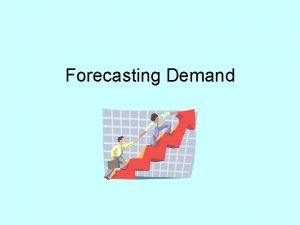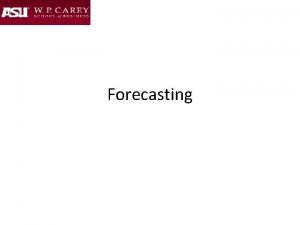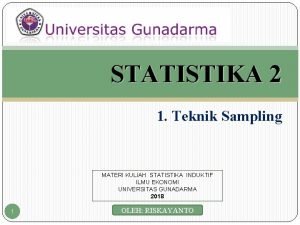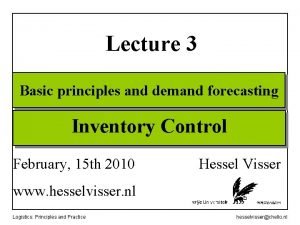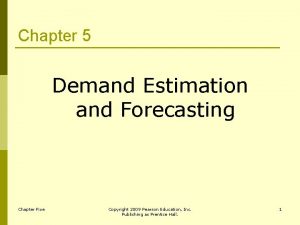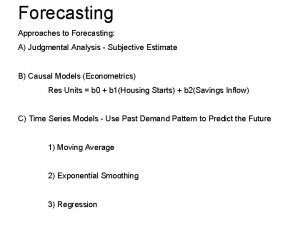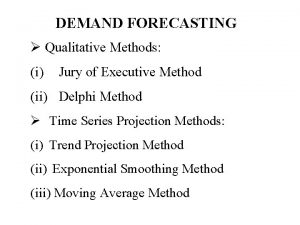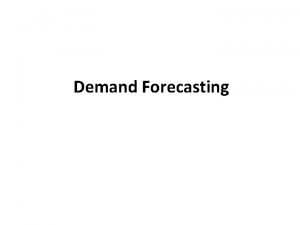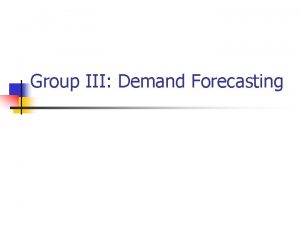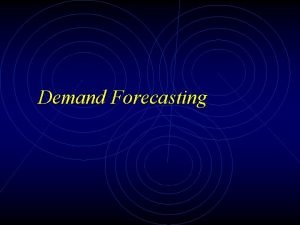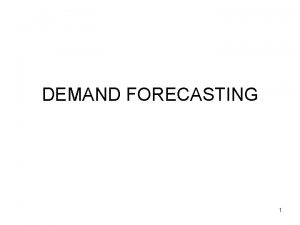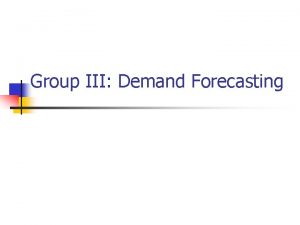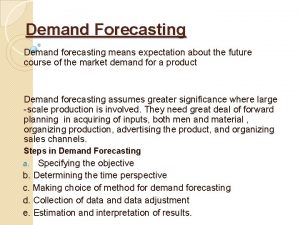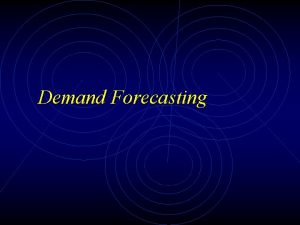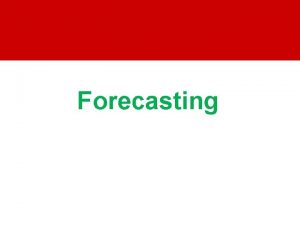Forecasting Demand Forecasting Methods Qualitative Judgmental Executive Opinion
















- Slides: 16

Forecasting Demand

Forecasting Methods • Qualitative – Judgmental, Executive Opinion - Internal Opinions - Delphi Method - Surveys • Quantitative - Causal, Extrinsic Factors - Time Series

Causal Methods Seek Relation between Sales and Economic Indicators (Especially Leading Indicators) Example: Door Lock Demand & Housing Starts Month Housing Starts Door Locks January 4000 350 February 5000 450 March 3000 300 April 6000 550 May 7000 720

Scatter Diagram of Door Lock Sales vs. Housing Starts

Time Series Forecasts Based on Past Demand Patterns or Components: • Average or Level • Trend • Seasonal • Cyclical (Omit) • Random (Cannot Forecast)

Time Series: Level Demand • Simple or Arithmetic Mean E. g. F 5 = (103 + 121 + 130 + 150) / 4 = 126 • Moving Average – Discard Old Data • Weighted Average Ft+1 = t Dt + t-1 Dt-1 + Etc. = Weight between 0 and 1, i = 1 D = Actual Demand t = Current Time Period (t=4) E. g. F 5 =. 4(150)+. 3(130)+. 2(121)+. 1(103) = 133. 5

Time Series: Level Demand Exponential Smoothing Weighted Average Ft+1 = Dt + (1 - )Ft Ft is Old Forecast from Last Period E. g. F 5 = (. 2)(150) + (. 8)(115) = 122

Time Series: Trends • Trend is Predictable Long Term Increase or Decrease in Demand • E. g. • Forecasting Techniques: - Regression (Least Squares) - Adjusted Exponential Smoothing January 103 February 121 March 130 April 150 If Trend Continues, Averages are Too Low

Scatter Diagram of Demand vs. Month Number

Time Series: Trends • Simple Regression: One Independent Variable E. g. Ft = a + bt (t is Time, a & b are Constants) F 5 = 88. 5 + (15)(5) = 163. 5 • Multiple Regression: Multiple Independent Variables E. g. Ft = a + b 1 t + b 2 i (i is base index) F 5 = 81 + (12. 83)(5) + (16. 67)(1. 05) = 162. 6 • We Can Use Excel to Get a & b’s

Time Series: Trends & Exponential Smoothing 1. Ft+1 = Dt + (1 - )Ft = 122 2. Trend Factor = (Ft+1 – Ft) = 122 - 115 = 7 Tt+1 = (Ft+1 – Ft) + (1 - ) Tt = Weight between 0 and 1, Often = Tt = Old Trend, Use Trend Line Slope at First E. g. Tt+1 =. 2(7) +. 8(15) = 13. 4

Time Series: Trends & Exponential Smoothing 1. Ft+1 = 122 2. Tt+1 =. 2(7) +. 8(15) = 13. 4 3. A Ft+1 = Ft+1 + (Lag)(Tt+1 ) Lag Can be (1/ ) = (1/. 2) = 5 E. g. A Ft+1 = 122 + (5)(13. 4) =189 Can You Do a Forecast for June?

Time Series: Seasonal Demand: Definite, Dependable Reason for Heavy Demand at One Time, Light Demand at Another 1. Construct Base Series or Index from Historical Demand 2. Divide All Demand by Appropriate Base 3. Forecast Using Any Method 4. Adjust Forecast by Multiplying by Appropriate Base

Evaluating Forecasts: MAD • MAD is Mean Absolute Deviation • Smaller the MAD, the Better • MAD = | Dt – Ft | / n Dt = Actual Demand Ft = Forecast n = Number of Periods

Evaluating Forecasts: MAD Example of MAD for May and June: Month Dt Ft May June 172 192 122 132 MAD = 110 / 2 = 55 | Dt – F t | 50 60 110

 Executive opinion forecasting example
Executive opinion forecasting example Qualitative forecasting methods
Qualitative forecasting methods Contoh judgement sampling
Contoh judgement sampling Judgemental adalah
Judgemental adalah Statistical methods of demand forecasting
Statistical methods of demand forecasting Demand forecasting methods in managerial economics
Demand forecasting methods in managerial economics Statistical methods of demand forecasting
Statistical methods of demand forecasting Jury of executive opinion method
Jury of executive opinion method Private opinion becomes public opinion when
Private opinion becomes public opinion when Freemans formula
Freemans formula What is forecasting in operations management
What is forecasting in operations management Logistics forecasting methods
Logistics forecasting methods Materi perencanaan dan peramalan keuangan
Materi perencanaan dan peramalan keuangan Arithmetical increase method
Arithmetical increase method Micro level demand forecasting
Micro level demand forecasting Demand estimation and forecasting
Demand estimation and forecasting Forecasting and demand measurement
Forecasting and demand measurement
